The toilet is leaking after flushing: possible causes of the problem and how to eliminate them
Any leak in plumbing or internal communications is a problem associated with financial losses, so it must be resolved immediately. If the toilet leaks after flushing or the sound of a babbling stream is periodically heard from the toilet, it’s time to check the condition of the tank. Do you agree?
We will tell you about the most common breakdowns that occur with plumbing equipment that is mandatory for furnished housing. Here you will learn how to deal with them on your own. Taking into account our advice, you can eliminate such situations and competently repair an important device for life.
The content of the article:
The first signs of water leakage
The flush function involves the long-term or short-term flow of water into the toilet bowl in order to cleanse it of waste products. The process begins by pressing the button built into the tank and ends arbitrarily or by pressing it a second time.
Instead of a button, there may be a lever or a handle on a chain, like retro models, but such options are extremely rare.
By pressing a button we control drain valve. It is connected to a locking mechanism, which, upon completion of the drainage, opens the way for a new portion of water to enter from the cold water system. Thus, flushing occurs only at the request of the user.
If water flows into the toilet after flushing or, even worse, constantly flows in a thin stream, it’s time to check the tank’s fittings - one of the parts has failed.
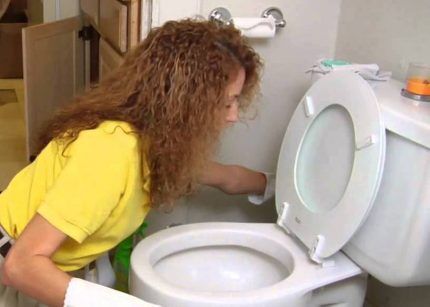
But first you need to determine that there is indeed a leak.
Signs of improper drain operation include the following factors:
- constant or periodically appearing characteristic sound of rushing water;
- rusty and limestone stains at the water outlet;
- a constantly wet inner wall of the toilet, close to the cistern, even if the toilet has not been used for a long time;
- an unusually long and weak flushing process - a salvo discharge is considered the norm;
- the appearance of condensate on the pipes and tank, which never existed.
The last symptom is associated with the constant movement of cold water through the pipe, whereas under normal conditions the water is used periodically and has time to warm up to room temperature before it is drained.
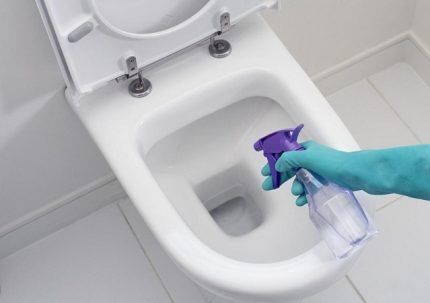
Sometimes the cause of leaks lies in the dirt that has accumulated at the bottom of the water tank. In this case, it is enough to thoroughly clean the internal surfaces of the tank. To do this, drain and turn off the water, carefully remove the fittings and, using a brush and cleaning agents, remove the sediment accumulated on the bottom and walls.
If operational cleaning does not help, you will have to become familiar with the design of the drain mechanism.
We disassemble the tank device
There are several common reinforcement designs that can be called standard.Among them is an outdated type of drainage device with a rubber bulb, assembled according to the simplest scheme and suitable for tanks with side connections.
This is a rare phenomenon, uncharacteristic of modern models. Let us turn to the current type of fittings, consisting of two modules: drain and float.
The float on a thick metal wire was improved and turned into a more complex structure that shuts off the water supply not from the side, as before, but from below, although side models are occasionally found. The position of the float from them is adjustable, so you can dose a portion of the drained water.

Due to the similarity of the fitting models, it is easy to replace the entire structure or change individual parts: the drain float mechanism, the drain lever.
To understand how each element works individually, you can disassemble the model installed in the tank. Of course, before this you need to take safety precautions: shut off the flow of water to the riser or supply line and empty the tank.
All parts can be unscrewed manually or using a set of keys. There are almost no metal parts; instead, only plastic elements have long been used. They are quite durable, do not deform when interacting with hard water, do not rust, and are easy to clean with household chemicals.
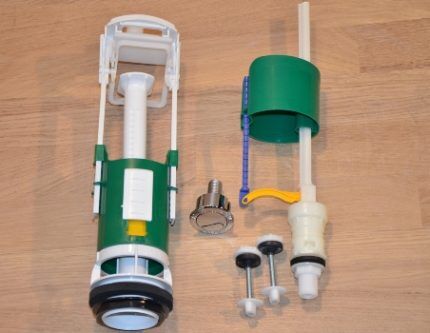
The sizes and colors of parts from different manufacturers may differ, but the operating principle is absolutely the same. Therefore, if the seal is worn out and a trickle of water constantly leaks from the tank into the toilet bowl, it is not difficult to find a replacement.
To be sure, you can measure the diameter of the ring or simply show the old gasket to the seller.
What to do if the toilet leaks after flushing, depending on the reason
There are several reasons for a leak to appear. Drainage problems may be caused by float failure, failure of the drain column, dirt clogged in the fittings, wear of rubber seals. Let's look at common cases of leaks and choose the best ways to solve problems.
Water is constantly flowing
One of the obvious signs indicating the need for urgent repairs is a thin trickle of water. If filters are not installed at the outlet of the main line from the riser, over time the “bed” of the stream becomes covered with a sediment of rust and mineral deposits. If water is constantly flowing in the toilet, what should you do in such a situation?
The cause of the leak must first be identified. It is clear that the problem is not in the toilet bowl or installation errors - the roots of the problem must be looked for inside the tank. First, we look under the cover and try to determine the breakdown visually. If this does not work, we dismantle it toilet valves in the following order.
If the drain mechanism is without dismantling the tank It’s impossible to get it, first remove the tank. To do this, unscrew the two fastening screws located on the underside of the toilet shelf.
The above instructions are universal and suitable for repairing drain fittings. Now let's move on to specific breakdowns.
The first reason is that the float mechanism has failed
Fortunately, this problem can be determined without removing the tank: you just need to look under the cap. If the float ceases to perform its function, then it does not rise to the desired level, but is constantly in one place.
It does not respond to an increased volume of water in the tank; as a result, the overflow system is activated and water pours into the toilet empty. Most likely, the float has lost its tightness and is sinking.
The second option is that the fastenings are broken. In any case, the broken model must be replaced with a new element. To do this, we remove the old float and take it with us so that we can present it to a consultant as a sample in a specialized market.
If after the next filling of the tank the leak stops, the problem is solved. But as insurance, it’s worth watching the mechanism work for a few more days.
The second reason is that the rubber seal has become unusable
The polymer or rubber sealing ring is the weakest point of the drain mechanism. It is located directly at the outlet of the water flow, so it simultaneously functions as a barrier that retains a variety of dirt, sediment, and mineral deposits from the pipes. As a result, the rubber either becomes dirty or wears out and frays.
In the first case it needs to be cleaned, and in the second it needs to be replaced. The remaining parts of the drain column are reliable; in other words, this part has nothing else to break. The valve is cleaned as follows.
If during cleaning you notice that the O-ring is damaged, it is better to install a new part. Signs of damage - deformation, cracks, micro-tears, general wear and tear. Even if it still retains its functionality, after a while it will begin to leak water again.
Leak observed after flushing
Sometimes you can observe the following picture: a flush occurs, and after it for some time, water flows into the toilet in an intermittent or even steady stream. Then the leak stops, but after the tank has been filled to its maximum.
Water losses are small, but even with a temporary leak, money goes down the drain, and the toilet bowl slowly becomes covered with plaque.
There may be several reasons:
- defective valve parts;
- skewed drain column;
- partial blockage in the water drainage area;
- failure of a small element of one of the valves.
To find out what's wrong, you need to make a visual diagnosis, and, if necessary, remove the drain mechanism or float valve.
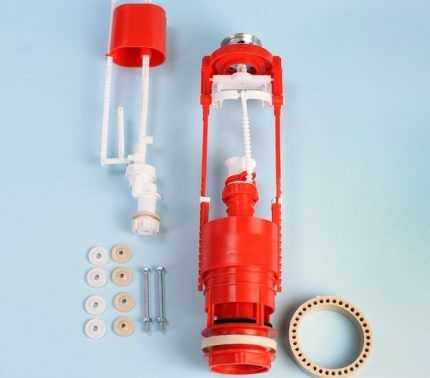
The distortion of the drain mechanism can be noticed immediately - the water release button begins to jam or even fall down. It is necessary to remove the cover and see why the column has lost stability. Perhaps she moved slightly out of the nest and changed her position. The situation can be easily corrected by returning the valve to its place.
It also happens that a fairly large mineral particle penetrates under the sealing ring and gets into the tank with the flow of water from the pipe. While there is little water in the tank, the pressure on the valve is weak, and the liquid continues to flow into the toilet in a trickle.
As soon as the tank fills, the pressure on the seal increases. It clamps a piece of mineral sediment and stops the leak. Cleaning the tank will correct the situation.
Home craftsmen love to improve factory parts, and even in such a simple design as a drain valve, they manage to find flaws. Here is a simple example of how you can get rid of minor but regular water leakage immediately after flushing.
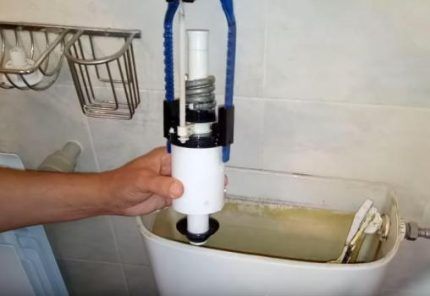
Even if the tank is empty, the weight will press on the seal, thereby creating a 100% tightness. In this case, even slight wear of the rubber will not spoil the functionality of the valve.
Preventive measures against leakage
To prevent a leak in the toilet from occurring at the most inopportune moment, you should monitor the condition cistern fittingsand regularly carry out preventive measures.
The main and at the same time the simplest thing is to clean all parts, as well as the internal surfaces of the tank. Upon careful examination, you will notice that even in a short time the walls and bottom are covered with a red coating, mineral deposits and even a substance similar to silt. The composition of contaminants depends on the quality of the water.
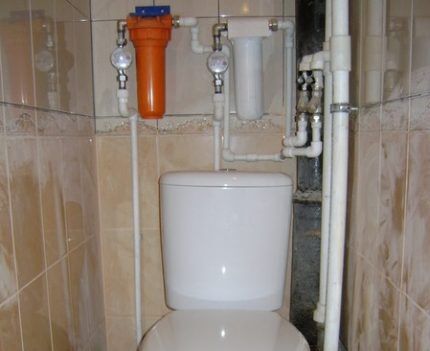
From time to time it is advisable to check the condition of the sealing elements, fasteners and parts that are located at the joints in order to anticipate the occurrence of a strong leak. A small amount of moisture indicates that the connection is leaking. Accordingly, you need to tighten the nuts or replace the seal.
Timely minor repairs and regular cleaning will save you from leaking water into the toilet, and therefore from unnecessary costs. An important factor ensuring savings in water, clogging and breakdowns is competently executed fittings setting, the specifics of which we recommend that you familiarize yourself with.
Conclusions and useful video on the topic
The best plumbing repair advisors are experienced home professionals. The results of their work can be seen in the following videos.
Video #1. Instructions for replacing fittings:
Video #2. How to avoid buying a new set of fittings:
Video #3. Replacing an old float with a new model:
All work related to cleaning or replacing drain fittings can be done independently.If you cannot find a breakdown, but you urgently need to fix the leak, you can simply install new fittings - the cost is low.
It is advisable to contact plumbers in one case: if you tried to correct the situation on your own, but failed for some reason.
Would you like to tell us how you fixed a leaking toilet yourself? Do you have useful information that you would like to share with site visitors and us? Please write comments in the block below.




The age-old problem of water leaking after flushing, regardless of when it was done last time, has also affected us. We did everything we could: we cleaned the rubber seal, changed defective valve parts, and installed a new float mechanism. However, the problem periodically arose again and again, and the reasons, oddly enough, were always different. Having fixed another leak problem, I began to carry out preventive maintenance.
It is not at all difficult to identify the cause of a leak and eliminate it yourself using a minimal set of tools and consumables. If water forms on the floor, then it is necessary to check the joints in the areas where the structural openings of the tank are located and, if necessary, install a new gasket to ensure the tightness of the connection.
It turns out women can do it too! So I decided to figure out on my own why water sometimes leaks in the toilet after filling it up. I drained it, unscrewed everything I could (I was afraid I wouldn’t be able to put it back together later), cleaned it of deposits, cleaned the gaskets, put everything back in place, and now it’s a miracle - it doesn’t leak anymore!
Apparently the sand that came with the water and remained on the gaskets (the house is a new building) - I cleaned it and everything was ok! It turned out that I was also a plumber. What has our life brought us to...
I threw the drain valve into white alcohol solvent overnight and that was all there was to it.
Yes, just change the sealing gaskets and the toilet will leak less often. We still have everything original from AM in our toilet. He had no leaks.
If you decide to fix the problem of a leaking cistern yourself, but have no experience at all, then the problem may begin with removing the lid. The lid cannot be removed until you remove the flush button. And the fastening system varies from manufacturer to manufacturer. As a rule, a small manual comes with the toilet when it is sold. Do not throw it away after installation! In mine, first you just need to pry off the key with a narrow screwdriver, and then use the special key from the kit to unscrew one plastic nut. And then we look at the text.
In 90% of cases, water leaks from the cistern into the toilet due to some kind of breakdown of the shut-off valves. This can be either the parts of the fittings themselves or the rubber band (by the way, most often it becomes stiff and clogged). The problem is that individual parts of this fittings are quite difficult to find and you have to spend money on the entire set. Washing the seal doesn't always help either. Someone keeps it in boiling water to soften it. But if the rubber is many years old, then it needs to be changed, as it is susceptible to natural destruction.
Just pour boiling water into the tank. 95% guarantee.
95% guarantee of what? The fact that the tank will crack due to temperature changes and the seals will be deformed? Even in washing machines, when washing at 90 degrees, it is thought out that the water is mixed with cold water when draining. The article describes in detail how to deal with the problem without such strange solutions.
Never pour boiling water into a tank - the tank will burst, tested from personal experience, I drained hot water from a bowler
Thanks for the advice, the barrel was fixed, the water flows as it should!
Truly: from the funny to the great there is one step. I wanted to change the sealing gasket, but I couldn’t find it. I took your advice with the screw, tied the nut and the problem went away.
Thank you so much!! I fixed the drainage system myself. The toilet is from Vidima, the tank has been leaking for a long time. I called a plumber and he said it was impossible to fix, only replacing the mechanism. Well, what should we do? We bought a system from Voronezh, and he took the one that was leaking. Now I understand that our old one was much better than what they replaced. It’s a shame I didn’t find your article earlier. But even now it helped.
I washed the fittings. To make the valve heavier, I wound a lead strip. If it doesn’t help, I’ll try to “soften” the valve in a solvent. Of course, you don’t have to do all this and buy a new unit, but... I ended up in the village with my mother, without a car. Can't get to the store.